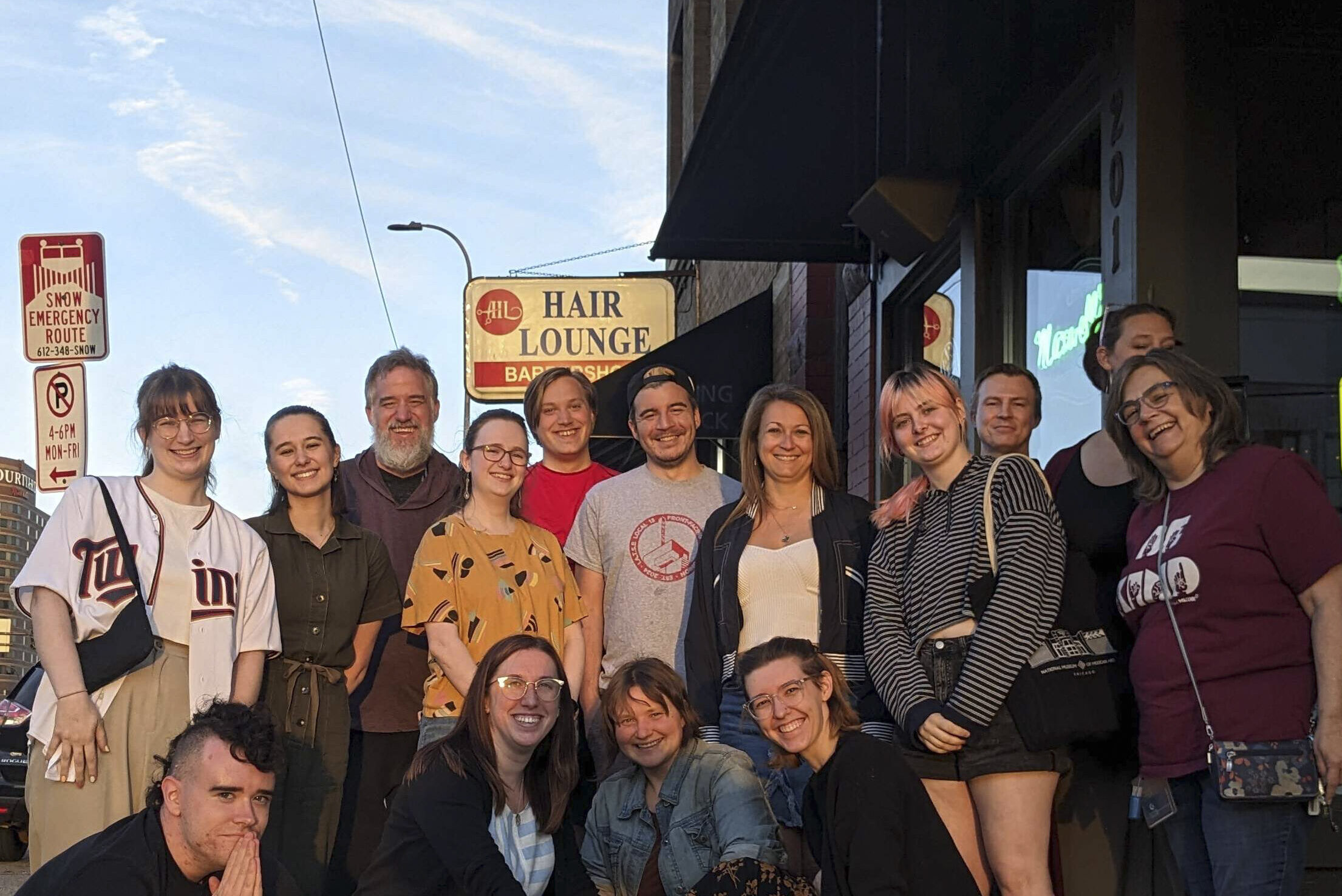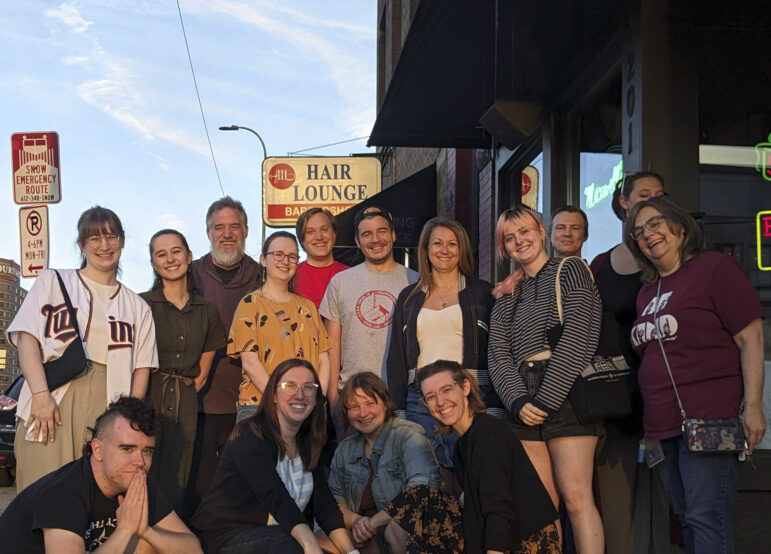
Guthrie workers gather for a photo after a union meeting.

Share
Eva Nereson, 23, has worked as a housekeeper at the iconic Guthrie Theater in downtown Minneapolis for the past three years, in both part- and full-time capacities. She describes her duties as cleaning “everything that people are likely to see when they come in and see a show at the Guthrie,” including the lobby, carpets, bathrooms, and inside the theater.
In June, the front-of-house workers of the Guthrie, which includes guest services workers, box office staff, lounge hosts, janitors, and ushers, won their union with 70% of workers voting in favor. Represented by International Alliance of Theatrical Stage Employees (IATSE) Local 13, the workers are preparing to bargain their first contract.
They are fighting for wage increases, reinstatement of some positions that were cut, more transparency of pay tiers, scheduling hours two weeks in advance, additional safety training, and support with parking. Some positions, like ushers, work short shifts, and the cost of their wages for the day are eaten up almost entirely by the cost of parking in downtown Minneapolis, workers say.
In interviews with Workday Magazine, they reflect on the importance of their role in the Twin Cities’ arts community—as many are frontline workers at multiple local venues, an increasingly unionized sector, and contribute as working artists themselves.
Nereson describes the moment of calm after crowds of theater-goers rush in for a show: “It’s very zen for me.” In addition to working at the Guthrie, Nereson also works at the Minneapolis Park Board as an event attendant, and goes to school at Minneapolis Community and Technical College, where she also works with the school’s theater department.
Nereson began working at the Guthrie in 2022, shortly after the theater reopened following the pandemic lockdowns. She has worked in other janitorial positions, and says when she first started it felt like “the best job I’d ever had.” The theater offered bonuses to workers, various benefits and perks, and had an overall very positive work culture, she recalls.
However, as the months went by, Nereson says a lot of these perks faded away, with workers facing cuts to holiday pay and a decline in overtime approvals, alongside a reduction in full-time positions, which intensified the workload for the remaining workers. “At no point were we asked about how those things would affect our jobs. In my department, we tried everything. We went to our managers and our managers’ managers. We tried going to HR but at some point it was just clear that none of that was working and we needed something else,” Nereson explains.
That’s when the 130 front-of-house Guthrie workers began the process of organizing a union. Now, seven months after winning the union, the workers preparing to bargain their first contract are not the only union workers at the Guthrie.

Photo courtesy of Eva Nereson
Guthrie workers gather for a photo after a union meeting.The theater’s stagehands, scenic shop workers, and stage actors are all unionized. Nereson says that seeing other unionized workers in the building made unionizing feel more attainable. The front-of-house workers also share that they received support and advice from the unionized sectors of workers throughout the process.
Nereson recalls one example of the union difference when workers across sectors at the Guthrie were laid-off in 2024. The workers without a union, Nereson recalls, “were laid-off with no notice. It was just like, boom, you’re out.” Whereas the workers with unions “got months before those cuts were supposed to happen, where they knew which positions were going. We saw that it doesn’t have to be like this.”
In a statement from IATSE announcing the shop’s unionization in June, Amanda Sager, an international representative with the union, said, “This group is passionate about the changes they want to see in their working conditions.” She added, “Minneapolis has always been a strong union town and Local 13 is proudly part of that wave. Despite the employer’s attempt at anti-union messaging, workers prevailed.”
Before workers can begin the fight for their first contract, the union was recently notified that they’ll need a unit clarification hearing through the Bureau of Mediation Services to determine the eligibility status of two specific positions.
The Twin Cities has seen a spike in workers at arts and cultural organizations forming unions over the last few years: at First Avenue venues, the Walker Art Center, the Minneapolis Institute of Art, the Minneapolis Children’s Theater, the Minnesota Historical SocietyMills City Museum, and the Science Museum of Minnesota. Nationally, other theaters have also seen front-of-house workers unionizing in recent years, including the Goodman and Steppenwolf Theatres in Chicago.
Nereson emphasizes the importance of these workers’ expertise and passion in contributing to the overall culture of the venue and for the Twin Cities arts community. “We interact with everyone in the building, patrons as well as other employees and working artists,” Nereson says. “We all have a role to play. We have that personal knowledge of what it takes to survive as a working artist. There’s a lot of passion there that comes from a personal place.”
In a statement sent to Workday Magazine, the Guthrie Theater said it “has a proud history of working with unions, including IATSE Local 13, and is endeavoring to build a positive, collaborative relationship with the unit it currently represents.” The theater said that it “partners” with other unions as well, including the Actors’ Equity Association and the American Federation of Musicians.
“Negotiations have not started with this new bargaining unit and, therefore, no proposals have been exchanged,” the theater said. “We are eager to begin negotiations the week of January 20 and look forward to working with IATSE Local 13 to come to a fair and effective contract. Those negotiations will go forward concurrent with the unit clarification process.”
Nereson underscores that workers know the Guthrie, and live theater generally, are struggling to recover since the closures following the pandemic. “A lot of us personally understand. We lost our jobs at the Guthrie when the lockdown happened, or lost our jobs elsewhere too. We saw very personally the effects of the shutdown on the local arts community. So we totally understand the challenges that are facing the Guthrie right now.”
“We are not doing anything or proposing anything that would exacerbate those issues,” Nereson says. “We’re super intentional about that because we want the institution to grow. It’s in the interest of bettering our departments, bettering our work, and doing the best we can.”

